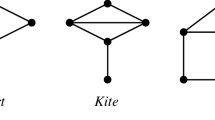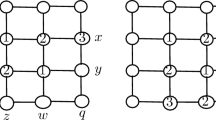Abstract
Indicated coloring is a graph coloring game in which there are two players jointly coloring the vertices of a graph in such a way that both can see the entire graph at all the time and in each round the first player (Ann) selects a vertex, and then the second player (Ben) colors it properly without creating a monochromatic edge, using a fixed set of colors. The aim of Ann is to achieve a proper coloring for G, while Ben is trying to create a situation where all the colors occur on vertices adjacent to some uncolored vertex. The smallest number of colors necessary for Ann to win the game on a graph G (regardless of Ben’s strategy) is called the indicated chromatic number of G, and is denoted by \(\chi _i(G)\). In this paper, we obtain some upper bounds for the indicated chromatic number of graphs and find a smallest 3-regular graph for which the indicated chromatic number is 4. In addition, we introduce the concept of criticality of graphs with respect to the indicated chromatic number. Also we show that \(\{P_5,K_4-e\}\)-free graphs are k-indicated colorable for all \(k\ge \chi (G)\).






Similar content being viewed by others
References
Arbib, C., Mosca, R.: On (\(P_5\), diamond)-free graphs. Discrete Math. 250, 1–22 (2002)
Bussmaker, F.C., Čobeljić, S., Cvetkovic, D.M., Seidel, J.J.: Cubic graphs on \(\le 14\) vertices. J. Combin. Theory Ser. B 23, 234–235 (1977)
Chartrand, G.: Chromatic Graph Theory. CRC Press, Boca Raton (2009)
Choudum, S.A., Karthick, T.: First-Fit coloring of \(\{P_5, K_4-e\}\)-free graphs. Discrete Appl. Math. 158, 620–626 (2010)
Erdös, P., Hajnal, A.: On chromatic number of graphs and set systems. Acta. Math. Acad. Sci. Hungar. 17, 61–99 (1996)
Pandiya Raj, R., Francis Raj, S., Patil, H.P.: On indicated coloring of graphs. Graphs Combin. 31, 2357–2367 (2015)
Grzesik, A.: Indicated coloring of graphs. Discrete Math. 312, 3467–3472 (2012)
Jensen, T.R., Toft, B.: Graph Coloring Problems. Wiley, New York (1995)
West, D.B.: Introduction to Graph Theory, 2nd edn. Prentice-Hall, Englewood Cliffs (2000)
Chang, G.J., Huang, L., Zhu, X.: Circular chromatic number of Mycielski’s graphs. Discrete Math. 205, 23–27 (1999)
Hajibolhassan, D., Zhu, X.: The circular chromatic number and Mycielski construction. J. Graph Theory 44, 106–115 (2003)
Liu, H.: Circular chromatic number and Mycielski graphs. Acta Math. Sci. 26B, 314–320 (2006)
Szekeres, G., Wilf, H.S.: An inequality for the chromatic number of a graph. J. Combin. Theory 4, 1–3 (1968)
Acknowledgements
For R. Pandiya Raj (File No. 09/559/(0077)/2011-EMR-I), this research was supported by the Council of Scientific and Industrial Research, Government of India.
Author information
Authors and Affiliations
Corresponding author
Rights and permissions
About this article
Cite this article
Francis Raj, S., Pandiya Raj, R. & Patil, H.P. On Indicated Chromatic Number of Graphs. Graphs and Combinatorics 33, 203–219 (2017). https://doi.org/10.1007/s00373-016-1747-2
Received:
Revised:
Published:
Issue Date:
DOI: https://doi.org/10.1007/s00373-016-1747-2




